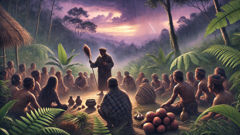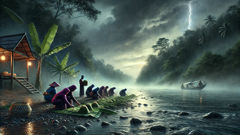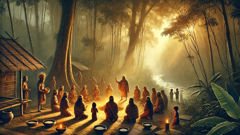Introduction
At the edge of the forest where the stream widens and the trail becomes soft with moss, the air listens differently. There, where canopy and clearing meet, the Semai speak in measured tones about thunder as if addressing an elder. Their thunder god is not distant thunderhead or nameless force; he is a presence with moods and appetites, a being whose anger can wet entire valleys or whose favor can coax a reluctant paddy into green abundance. The Semai do not merely tell stories about the thunder god; they live under an ongoing conversation with him. Children are taught the gestures and quiet words to use before crossing a clearing on a hot, heavy day. Gardeners leave small offerings at the roots of rubber trees and plantains. Hunters adjust their paths to avoid whistling in certain groves lest they provoke a crack of sky. These practices are pragmatic as much as spiritual: storms can mean loss of food stores and damage to reed shelters; lightning can cut a tree trunk in half and change a life. At the same time, the relationship bears a psychological logic. The thunder god embodies a community's memory of weather's unpredictability, an archive of seasons when rains failed and rivers receded. Appeasement rituals and songs are thus both survival technique and cultural narrative—ways to translate fear into action, to draw a rhythm of reciprocity between human beings and the weather above. This story follows the Semai's myths of origin and the rites that thread through daily life, listening for the fine balance between reverence and negotiation. It traces how elders shape meaning for children, how a single storm can be read like a page of history, and how modern pressures—roads through forest, changing climates, and contact with broader society—alter the grammar of those old conversations. Along the way, the tale keeps close to the land: the scent of damp earth, the tremor of distant thunder, the soft clack of a bamboo container being set out at dusk. These images carry the largest truths for the Semai: that weather is not just weather, that thunder is more than noise, and that living with the thunder god requires humility, craft, and a willingness to listen.
Origins of Thunder: The Semai Cosmogony and the Thunder God's Place
In the beginning of the Semai telling, weather is woven into relationships rather than into a catalog of natural phenomena. The thunder god arrives in the earliest pages of cosmogony as an agent of change—sometimes clumsy, sometimes intentional—whose breath clears the skies or splits the horizon with fire. In one widely told origin story, the thunder god was once a young hunter who sought to possess all sound. He chased birds and beat hollow logs until the forest could no longer hear itself. Annoyed spirits taught him that sound belonged to the whole of the world and, as punishment, they gave him the booming voice of thunder. The gift came with a caveat: his voice could shape the weather, and with it the fates of those who relied on the rain. Whether or not this particular narrative is told exactly this way in every Semai hamlet, the contours remain consistent: thunder is given agency and moral force.

From that beginning, a whole vocabulary of character, motive, and consequence grows. The thunder god is described as capricious yet bound by rules. He is not wholly malevolent; he is a force that responds to neglect and to certain kinds of disrespect. If villagers leave scraps or trash in sacred groves, if they cut a tree without asking the spirits first, if they mock an elder's ritual, thunder grows loud and near. Conversely, attentive acts—cleansing a spring, performing a night song, or offering a string of tuber roots at a river bend—can calm him. These details matter because for the Semai they represent a moral ecology: the landscape is not inert, it is a forum of debts and reciprocities where human behavior influences weather and vice versa.
Listening closely to Semai elders reveals how thunder stories function as both mnemonic and instruction. An elder might sit by a wooden bowl and recount a season when a family failed to perform a rain-song after clearing a new swidden field. The narrative will map the sequence of events: a bluebird's absence, a dry spell that reduced river flow, and then a single night of violent lightning that felled a cherished tree. The story ends not in shock alone but in how the family repaired the offense, bringing new offerings and teaching the younger ones the correct incantation. This process—infraction, consequence, repair—is a pedagogical device. It trains community members to read weather and ritual as a cycle in which missteps can be corrected.
Another layer to the origin narratives is the way the thunder god is integrated into family and clan identities. Certain lineages claim songs or incantations specific to their ancestors, songs that function like keys to particular pathways of negotiation with the thunder god. These songs often contain place names, old hunting routes, and references to kin whose lives were defined by weather events. Through them, clans archive their history, making the thunder god a witness to genealogy. When a clan leader chants an old rain-song, he is not only petitioning for rain; he is invoking a network of memories that reaffirms migration routes, alliances, and losses. The thunder god occupies a liminal space where social memory and ecological need meet.
Oral form matters. The Semai do not write their myth in stiff, codified text; they sing it, perform it, and embroider it with gesture. Children learn through playful imitations of thunder: they beat hollow gourds or clap on the back of a canoe, mimicking the cadence of thunder to invite curiosity and to learn boundaries. These playful acts are training in tone: loudness, timing, and restraint. There is etiquette embedded even in imitation. You must not perform the thunder rhythm near a cemetery or at the height of midday when the air is still and heavy. That kind of respect keeps the thunder god's attention mild rather than hungry.
Local ecology shapes the mythology as well. In valleys where the river broadens into calm reeds, the thunder god is often a water-linked figure, blamed for sudden floods when his temper is high. On ridges where lightning splits ancient trees, he is more closely associated with fire and wood. The Semai thus map features of the natural world onto the god's attributes. This mapping offers practical insights: in reed-rich regions, specific offerings—bundles of cut reeds bound with tiny strips of cloth—are the customary gifts; on ridges, offerings might include smudges of ash or a carefully carved wooden charm. These distinctions are not arbitrary; they embody local knowledge about how different landscapes show the thunder god's presence.
The mythology adapts to the community's needs. During times of repeated drought, elders will revive certain songs that have lain unused, songs that older members recall only faintly. They will also innovate rituals that combine older practices with new understandings—perhaps leaving offerings not only at river bends but at the foot of a newly installed water pump. Yet even in innovation, there is a desire for continuity: the form of the ritual must resemble the old patterns so the thunder god will recognize it. Recognition matters: myths teach that the thunder god has a memory of human practice. He rewards consistent patterns and punishes sudden, baffling departures.
More than an origin story, these myths create a moral geography. They name places where the thunder god was once seen—ruined stone piles, the stump of a great tree, a bend in the river where the current takes a sudden turn. They attach warnings and instructions to those places. A traveler who passes such a spot without making a small gesture risks a storm on his way home. In that way, the stories create a map of safety. The thunder god, then, is both a dramatic character in narrative and a regulatory force in the communal life of the Semai.
As the world changes and new pressures press against traditional lifeways—plantation boundaries, logging tracks, newcomers building roads—the mythic map shifts too. Elders worry that broken pathways will erode the thunder god's attentiveness. Yet they also adapt the narrative, integrating new landmarks into old songs. A quarry that once had no place in the telling might become the site of a new cautionary tale: a place where the thunder god was disturbed and where the land responded in kind. The resilience of myth lies in this elasticity. It is not a fossil but a membrane that breathes with circumstance, holding the community's memory while allowing for new stories to enter the fold.
Rituals, Negotiation, and Living with Storms: Practice and Adaptation
Ritual practice among the Semai is less about spectacle and more about calibrated gestures that thread through everyday life. A rain-song is rarely a single event performed only by specialists; it can be a sequence of small acts distributed across time and people. One family may begin the process by sweeping the hearth thoroughly and offering the dust to the roots of a banyan tree. Another might bring a teaspoon of rice to the river and lay it on a flat stone. These acts accumulate meaning. The thunder god, so the Semai believe, pays attention to patterns as much as to grand ceremonies.

At the center of many rain-appeasement practices is sound. Songs carry names, instructions, and the cadence necessary to call weather gently. They are often sung at twilight when the world is cooling and the air is open to alteration. The songs themselves are layered with harmonies that mimic the rhythms of rolling thunder: a low, sustained drone under higher, quicker motifs. Practitioners sometimes say that part of the skill in these songs is the ability to leave silence—an intentional pause that creates space for the thunder god to respond. Silence functions like an invitation.
Offerings are chosen with both symbolic and ecological sensitivity. Root vegetables and tubers are common because they represent underground generosity and the cycle of nourishment that the land returns. Small woven mats of banana leaves, filled with roasted grains or a sliver of smoked fish, are left at stream forks. In certain regions, the Semai tuck a tiny bit of resin or sap into a folded leaf to place at the base of a large rock—a token meant to sweeten the thunder god's temper. The materials are locally sourced and biodegradable, reflecting a practice that seeks to restore balance rather than to accumulate.
Ritual professionals—sometimes called on for greater storms—are not priests in a hierarchical sense but respected elders who possess memory: songs, incantations, and a sense of the right moment. Their role can be invoked when rehearsed rituals fail to bring relief. They will often combine song with action: laying out a protective cord around a hamlet, marking a boundary with painted dots of lime, or performing a short, sharp drum pattern that mirrors the rhythm of lightning's strikes. These acts are part physical, part symbolic; they aim to reestablish the pattern that the thunder god recognizes as orderly and respectful.
Stories handed down about past negotiations with the thunder god function like case law. The community recalls the sequence of offerings and sayings that worked in particular circumstances. A severe storm forty years ago might still be recounted in detail: who led the ritual, which songs were used, which offerings were left, and which household survived relatively unscathed. These retellings serve practical ends; they help the community adapt to new weather patterns by consulting the body of remembered responses.
Negotiation is not always straightforward. The thunder god, by Semai accounts, is capricious because he is also responsive to emotion. If a clan approaches a ritual in anger or with secret quarrels among its members, the thunder god senses the discord and may withhold rain or magnify storms. Because of this, many rituals begin with reconciliation. Elders arrange meetings where those in conflict will exchange small gifts, apologize, and restore social harmony before the main ritual begins. This social choreography recognizes that weather response is entangled with social cohesion: storms are treated as a measure of the group's internal balance.
Modern challenges complicate the ritual economy. Deforestation, agricultural change, and new infrastructures both disturb the thunder god's familiar landmarks and introduce new actors into the ecological story. For example, a logging road that cuts through a sacred grove can be read as a breach that requires repair. In some villages, elders have negotiated with logging companies to set aside small protective strips of forest or to mark certain trees as off-limits. These negotiated protections behave like contemporary ritual: a secular agreement enacted to preserve the symbolic order that keeps weather patterns legible.
Climate variation forces further adaptation. When rains come at unexpected times or when seasons stretch beyond their usual bounds, the Semai respond by revising the timing of songs and the placement of offerings. They may perform an older, longer rain-song more frequently, or invent a brief invocation suited to the swifter storms that now arrive. These innovations are pragmatic, but they also testify to cultural resilience. The community recognizes that if the thunder god is called by new names—for example, new patterns of lightning linked to distant industrial emissions—then the practices that address him must change in form while maintaining a thread of continuity.
Encounters with outsiders also reshape practice. Missionary presence, formal education, and tourism have sometimes misunderstood or romanticized rituals, leading to awkward exchanges. In one village, a well-meaning tour operator staged a mock rain-song for visitors, using props and simplified chants. Elders were offended; they felt the ritual's cadence and meaning had been flattened. Subsequent dialogue led to a different outcome: the village offered a respectful explanation to the operator about the careful conditions under which songs should be performed and encouraged community-led cultural demonstrations that retained context. The result allowed for cultural sharing without ritual erosion.
Crucially, the Semai maintain a set of pragmatic rules about when to act alone and when to call for collective effort. Small, personal appeasements can often calm localized disturbances—an offering at a garden edge might suffice when a single hut is struck by unlucky lightning. But when storms gather in scale, collective action becomes necessary. Then the entire village will gather, sometimes bringing neighboring hamlets together, to perform round-the-clock watch-songs and to keep protective fires burning in specific patterns meant to guide lightning away from living spaces. These communal moments reinforce social bonds, turning fear into a cooperative enterprise.
The thunder god also figures in moral instruction. Parents use thunder stories to teach patience, humility, and respect for nonhuman life. A child who takes too much from a mango tree without offering thanks can be quietly told of a family that once suffered a season of poor fruit following such behavior. The lesson is discreet and woven into daily life. It encourages a form of reciprocity that works as an environmental ethic: give a little back to what you take.
Living with the thunder god is not only about defense against harm. It is also about learning to read the sky as a partner. For the Semai, weather prediction involves not only observation but conversation: listening to wind patterns as if they were sentences, watching the angles of light that signal a change in the air's mood, and attending to animal behavior that has always acted as a barometer. In this way, the thunder god functions as both challenge and teacher. He can be feared, yes, but he can also be understood. When the community learns to interpret the signs he leaves—the way clouds gather at a particular ridge or the precise timing of the first cricket song—people are able to act in ways that protect their lives and livelihoods.
Ultimately, the Semai relationship with the thunder god is less a static devotion and more a dialogic practice. It blends myth with observation, ritual with social order, and memory with adaptation. In a changing world, this flexible conversation becomes a kind of quiet wisdom: how to honor power without surrendering agency, how to transform fear into structured care, and how to remain attuned to the weather's language so that each storm becomes not only a hazard but also a moment of renewal and moral learning.
Conclusion
The Semai people's stories about the thunder god are more than folklore; they are living protocols embedded in daily life. These narratives and rituals form a cultural infrastructure that structures behavior around weather's unpredictability, turning anxiety into purposeful action. The thunder god, in Semai imagination, is a demanding yet recognizably human presence: he remembers, he rewards, he scolds, and he forgives when given reason. Community memory—kept in song, offering, and place-name—translates into resilience. Elders instruct the young, not by delivering decrees but by teaching songs, setting out offerings, and modeling the careful etiquette that keeps storms manageable. Outside pressures—deforestation, modern infrastructure, and climate shifts—pose real challenges to these practices, but the Semai adapt through negotiation, selective innovation, and the preservation of key ceremonial patterns. Their approach suggests a broader lesson: that a respectful, reciprocal relationship with the natural world can be a form of practical knowledge, not merely spiritual consolation. In the hush before a storm, when leaves stop and the air goes thin and attentive, the Semai listen for a response. The thunder god's voice is thunder; his answers are the soft resumption of rain, the steady return of the river, and the quiet reassurance that life continues when people remember how to speak with the sky.













